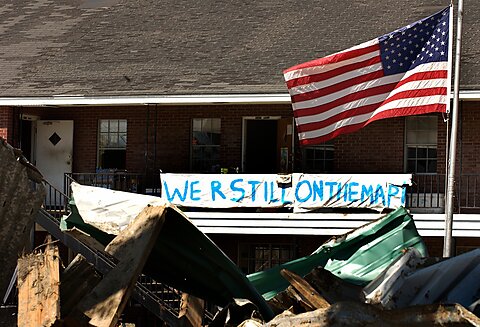This month, the Federal Emergency Management Agency (FEMA) Review Council will release a report aimed at improving federal disaster response. Over the last decade, FEMA’s annual spending has grown from $19 billion in 2016 to $32 billion in 2025 (adjusted for inflation). The FEMA Review Council’s recommendations should be informed by the ballooning costs of federal disaster programs, the numerous problems that accompany federal intervention into local affairs, and America’s long history of successful bottom-up approaches to disaster response. As Trump said, “We want to wean off of FEMA, and we want to bring it down to a state level.” The president is right.
Below, I highlight a few of the many problems with FEMA and suggest several reforms that would strengthen the disaster process, save taxpayer dollars, and return responsibility to the states.
The Problem with Federalizing Disaster Response
The federal disaster process shifts costs to national taxpayers, encourages rebuilding in harm’s way, and crowds out the local expertise needed for a fast, effective recovery. Here are six major problems with the federal disaster process.
Moral Hazard: States tend to free-ride on the federal government by requesting aid whenever they can, resulting in excess disaster spending and underinvestment in disaster preparedness. The National Flood Insurance Program (NFIP) exemplifies this problem. By providing flood insurance at subsidized rates, the NFIP encourages development in flood-prone areas by shifting the financial risk from property owners to taxpayers. This misalignment of incentives leads to elevated risk-taking and repeated bailouts. In other words, federal aid can contribute to more deadly, costly disasters.
Regressive Subsidy: Federal flood insurance, like broader federal disaster aid, functions as a regressive subsidy for wealthy landowners. Wealthy developers and higher-income, high-asset households—particularly in coastal zones—tend to benefit more from post-disaster aid and subsidized flood coverage. That’s an unjust product of the disaster process that is dictated from the top down.
Interstate Equity: The current disaster process is geographically regressive, acting as an interstate redistribution scheme. Per FEMA, just five states (California, Florida, Texas, Louisiana, and New York) and two territories (Puerto Rico and the Virgin Islands) account for nearly three-quarters of the Disaster Relief Fund’s catastrophic obligations to date. Tax dollars, on average, are extracted from poorer inland states and sent to wealthier, more disaster-prone coastal states.
Expertise: States, localities, and private entities tend to be more in tune with what happens on the ground and more capable of administering aid and overseeing mitigation projects. Accordingly, the more Washington centralizes dollars and decision-making, the more it crowds out local expertise.
Efficiency: The federal approach to disasters suffers from fragmentation, duplication, and burdensome top-down mandates. These problems are symptomatic of a federal role that has sprawled far beyond true catastrophes. Federal disaster aid packages illustrate this problem well, frequently being packed with wasteful pork barrel spending that hitches a ride on urgent disaster bills.
Overstretch: Old disasters make up a significant chunk of FEMA’s yearly budget. Between 2025 and 2028, for example, FEMA projected spending $156 million on Hurricanes Katrina, Rita, and Wilma from 2005 and a further $22 billion on COVID-19. As disasters and disaster designations proliferate, the number of emergencies on FEMA’s plate will grow, as will annual spending needs. Already, FEMA is struggling to manage newer disasters without overextending its resources. If states shoulder more of the disaster response process, FEMA can more effectively respond to crises as they arise.
My Cato colleague, Chris Edwards, highlights additional problems with FEMA here and here.
Promising Reforms to FEMA
The federalization of disaster aid has created a series of perverse incentives that harm disaster mitigation, complicate disaster response, and result in wasteful spending. Short of eliminating the agency wholesale, FEMA’s mission should be limited to managing large-scale disasters that cross state lines and overwhelm local resources, while routine disasters should be handled by state and local authorities. Accordingly, the federal government should downsize FEMA, phase out federal aid, and incentivize a more just, responsible, and effective state-led disaster process.
The FEMA Review Council, Congress, and the White House should consider the following reforms:
Right-size the federal cost share. The Stafford Act requires the federal government to cover 75 percent of eligible disaster response and recovery work, with states and localities covering the remaining 25 percent. Over time, presidents have voluntarily increased this share to as high as 90 or 100 percent. FEMA should return to the Stafford Act’s 75 percent minimum cost-sharing requirement, with the federal government’s cost share eventually being phased down to zero except in truly extraordinary circumstances.
Raise the bar for federal disaster declarations. To unlock significant federal assistance, the president needs to approve a governor’s request for a major disaster declaration. This declaration is based on a per capita cost formula that has resulted in presidents issuing more disaster declarations over time. Between President Reagan and Trump’s first term, for example, major disaster declarations rose from only 16 to 124. Increasing the declaration threshold would correct for this “disaster inflation,” reduce federal costs, and shift responsibility back to the states.
Adopt a disaster deductible to reward readiness. In 2017, FEMA considered adopting a “disaster deductible,” an insurance-style threshold that required states to cover a preset amount of disaster costs before federal aid kicked in. This deductible would scale based on a state’s fiscal capacity and disaster risk—higher for states like California or New York, lower for states like Alaska and Wyoming. Done right, conditioning disaster aid in this manner could reduce the regressivity of aid, improve incentives to invest in disaster mitigation, and limit the need for future federal interventions, thereby reducing the costliness and deadliness of disasters.
Expand Coastal Barrier Resources Act “no-subsidy” zones. The Coastal Barrier Resources Act is a Reagan-era law established to conserve coastal barriers by prohibiting federal financial assistance for development, including federal flood insurance. These coastal barriers provide important protection against storms and erosion, reducing the costliness and deadliness of coastal disasters. Expanding these “no-subsidy” zones would be an environmentally friendly, free-market approach to disaster management.
Privatize the National Flood Insurance Program. The NFIP creates a moral hazard by subsidizing development in high-risk flood zones, funded by taxpayers who would not otherwise bear these costs. Transitioning to a fully private flood insurance market would better align costs with actual risks, incentivizing safer development and reducing the taxpayer burden. Coupling such a privatization with targeted, means-tested subsidies would ensure vulnerable populations are not left without relief while also being less regressive than the current system, which disproportionately benefits wealthier households that choose to live in high-risk areas.
Other reform ideas deserving consideration include refocusing FEMA to prioritize immediate needs by time-limiting disaster spending, streamlining the aid delivery process, and fully offsetting any new emergency spending with automatic spending cuts.
Disaster policy is most effective when incentives are aligned, and decisions are made as close as possible to the people affected. Returning greater responsibility to the states and decentralizing the disaster process will result in less risk-taking, better mitigation, and a fairer deal for taxpayers.
















